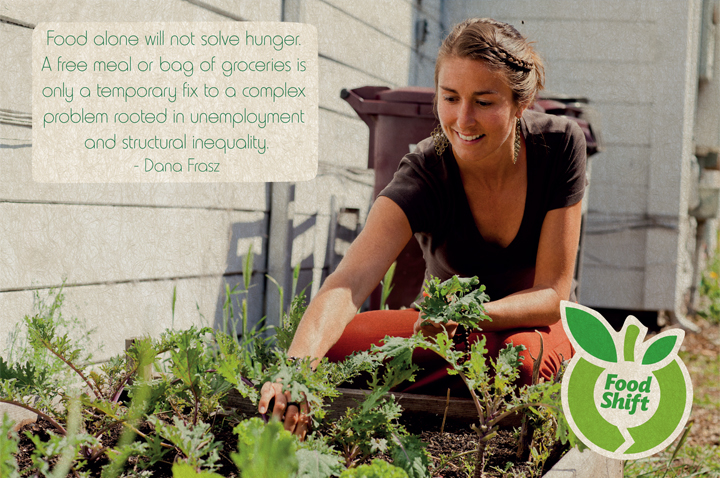Don't Want that Sandwich? Can't sell it? Don't throw it away, though!
Dana Frasz is a food entrepreneur. She wants to recycle food, taking the food that’s not consumed and putting it into the hands of those who cannot afford it. She wants companies to stop wasting so much food – at the grocery story and in restaurants. She wants us all to be aware of how much we’re throwing in the dustbin. Too idealistic? Frasz would argue otherwise. Hear her talk about her passion –FoodShift.
How much waste is there currently in the US and how accurate are these figures?
40% of all the food produced in the US is wasted.
This figure is from national experts on food waste – author, Jonathan Bloom wrote “American Wasteland: How America Throws Away Nearly Half its Food” and Dana Gunders has been researching this issue for at the Natural Resources Defense Council.
What are grocery stores doing currently to prevent food waste? Are there any policies in place to prevent this?
Some grocery stores are donating excess food or marking down the prices of food that is still good but may be past its peak freshness, damaged in some way or cosmetically imperfect. There is a federal policy in place to encourage food donation. It’s called the Good Samaritan Food Act and it was passed specifically to encourage the donation of food. It protects food donors from liability as long as they are donating to a non-profit. Many food donors can also receive tax deductions for their donations.
What has been the toughest part for you, as an activist and a social entrepreneur, in this effort?
I am really disturbed by the excessive waste and consumption in American culture.
Our materialistic lifestyles in the US have negative social and environmental impacts around the world. Rather than living in harmony with the earth, we are perpetuating a culture that is dependent on exploitation, extraction and acquisition. Food waste is not only a waste of nutrition, it squanders water, depletes soil, wastes fossil fuels and adds greatly to the world’s carbon footprint.
What is your solution?
Food Shift is working with Oakland schools to ensure surplus food from the cafeteria is redistributed to students and families rather than thrown in the garbage. We are working with a local grocer who has expressed interest in paying Food Shift to recover food from their stores. This would allow us to employ someone in the process while reducing waste disposal costs for the business. We are interested in developing food recovery and redistribution models that increase access to more nutrition food, reduce waste and generate revenue in some way so they can sustain and scale – like low-cost markets and value-added products.
How feasible is it?
We have trash and recycling removal in this country, why not have a food recovery service sector that recovers and redistributes surplus food as an extension of our current waste management system?
It may sound crazy, but it is realistic strategy and could create a lot of jobs in the green economy. Generating revenue from food that would otherwise be wasted is possible, but by no means easy. It’s a difficult challenge to ensure food safety, to establish new distribution channels and to pilot new models that are outside of the current norm.
Why do stores not simply list fresh foods items as 50% off at night, an hour or so before closing? That seems to make sense to avoid waste and still make some money.
It makes so much sense – and people love a good deal. Berkeley Bowl estimates it sells $1,500 per day of produce off its bargain shelf, which offers bags of damaged or nearly expired produce for 99 cents, Andronicos is running a program with Food Star to sell cosmetically imperfect produce at a low cost and Zero Percent is a technology that is allowing food establishment to post their surplus through an online application at either a discount or for donation. These are all great innovations that more businesses should adopt to reduce waste, save money and protect the environment.
Are there models for food waste elsewhere in the world (that you’ve read/seen) that you would like to see implemented here in the US?
The United Kingdom is leading the way on this issue. A campaign there called Love Food Hate Waste has reduced food waste by 18% over the course of 5 years. The UK has also standardized date labels so they are not so confusing for consumers. Many grocery stores there provide storage instructions for fruits and vegetables and informational tips and ads are displayed in over 12,000 stores. Instead of buy-one-get-one-free promotions, some UK stores are piloting a buy-one-give-one-free or get one later program. I also really like Rubbies in the Rubble – a company in the UK making jam and chutney from rescued produce.
What can each person do?
Become a food waste champion within your family and circle of friends! There are lots of recipes and other tips online. Here is a storage guide. And until May 12th you can vote for Food Shift in this contest to win $50,000 of free advertising on San Francisco’s public transit system. If Food Shift wins this contest, it would mean thousands of people would be exposed to informational ads about the social and environmental costs of wasted food. Our campaign would be the first of its kind in this country and would inspire and invite Bay Area residents to be part of the solution. Help us win by voting now and sharing with your friends! http://bit.ly/ZfntKG



On Dec 7, 2014 RKB66 wrote:
http://www.fynefutures.org....
Post Your Reply